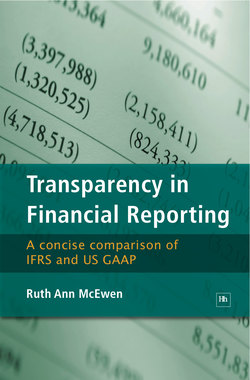Читать книгу Transparency in Financial Reporting - Ruth Ann McEwen - Страница 4
На сайте Литреса книга снята с продажи.
Introduction
ОглавлениеBy January 1, 2012, all major economies will provide financial reports using International Financial Reporting Standards (IFRS) except for Argentina, Greenland, parts of Africa and the United States. While the US Securities and Exchange Commission (SEC) recently published a roadmap for transition from US GAAP to IFRS, the roadmap does not include an irrevocable transition date; instead, mandatory adoption will depend on accomplishing objectives represented by milestones. It is likely that these objectives will be met and transition will occur by 2016. This work will set out the key differences between IFRS and US GAAP from a practitioner’s perspective, although financial analysts also will benefit from the material presented. The work identifies issues related to potential adoption of IFRS in the US and is aimed at intermediate to advanced practitioners and analysts.
IFRS differs in many respects from US GAAP, but no difference is as substantive as the IFRS view that all assets and liabilities can be revalued to fair value each reporting period, implicitly suggesting that only one value is “fair” and that managers are able to measure it. Unlike IFRS, US GAAP recognizes assets and liabilities at cost and, in most cases, revaluation reflects only decreases in value.
Balance sheet items are shown net of adjustments that keep assets from being overstated and liabilities from being understated. Alternately, assets and liabilities under IFRS are revalued each period to reflect both increases and decreases in value. Under both US GAAP and IFRS, decreases in value lead to unrealized losses that are recognized into current earnings or equity. Under IFRS and in fewer circumstances under US GAAP, increases in value lead to unrealized gains that may be recognized into current earnings. Recognition of these unrealized (no transition has occurred) holding gains may seriously inflate measures of earnings and income.
IFRS, and in certain circumstances US GAAP, is viewed by some as providing useful information for investors and creditors because of the fair value requirement. Under either system, revaluation methods may be straightforward or extremely obscure. An example of a straightforward method would be revaluing a building at a price for similar buildings in a similar area in a functioning real estate market. But most revaluations are not straightforward.
More obscure methods employ pricing models based on unobservable inputs in markets that are not fully functioning. For example, consider the case of fair valuation of a contingent consideration acquired as part of a business combination. Recognition and periodic revaluation requires estimates of the cash flows associated with the contingency (usually based on a subjective probability distribution) and the choice of an appropriate discount rate reflecting the risk of the acquired entity. Depending on the nature of the consideration, active markets may not exist. Both IFRS and US GAAP require the consideration to be recognized at fair value and that its estimates and managerial judgments be disclosed. But even with extensive disclosure about cash flow estimates and risk analysis, additional disclosure does not guarantee greater transparency or enhanced usefulness of the financial information being presented.
The financial crisis which began in 2008 has been attributed to, among other things, a perceived lack of transparency in the financial markets. In general, transparency implies an ability to see the reported results of an entity’s financial activities clearly and to use these results in making investment decisions. At question is the belief that transparency in financial reporting will lead to transparency in financial markets. Unfortunately, this link may be more subjective than most of us wish.
This book presents an analysis of reporting issues affecting transparency under IFRS, compared with US GAAP, and suggests areas of concern for preparers and users of financial reports. I also provide a technical analysis of major accounting issues raised by convergence, and indicate areas of interest during initial adoption of IFRS by US entities.
